Modernizing a legacy application is rarely a purely technical endeavor. It touches budgets, culture, talent, and customer experience all at once.
In this article, we will briefly take a look at some of the most common reasons behind modernization, dive deep into the four groups of application modernization challenges, the negative impacts they have on businesses, and ways to address these challenges for the best outcome.
Legacy systems, though functional, often carry a significant burden of outdated code and infrastructure—an accumulation of "technical debt" that makes modernization a more complex and costly process. It leads us to the first group: legacy application modernization challenges associated with tech debt.
Application modernization challenges related to existing technical debt
The first large group of software modernization challenges is related to pre-existing conditions. They are the results of the natural evolution of any software (aging) and a less-than-ideal approach to its management. For instance, lack of efforts dedicated to tech debt management or proper documentation are often among the reasons for mounting technical debt.
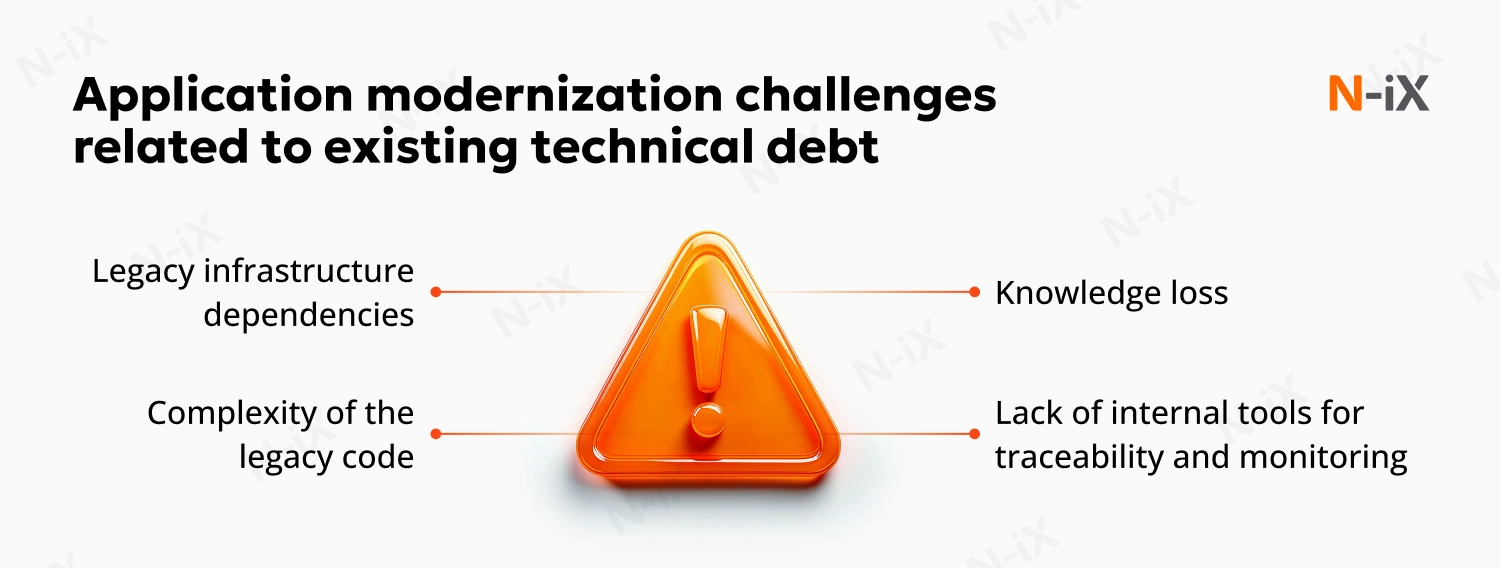
Let’s take a look at the most common application modernization challenges that stem from the age of the system itself.
Legacy infrastructure dependencies
Legacy applications often rely on outdated hardware or on-premises environments that are expensive to maintain and difficult to scale. These systems can create significant disruptions in operations, particularly as businesses strive to meet modern demands.
How it disrupts operations:
- Inability to integrate with modern platforms or APIs
Legacy systems often cannot connect with newer technologies, limiting the ability to innovate and integrate with essential modern tools.
- Higher operational costs
Maintaining niche hardware and managing outdated licensing agreements can incur unnecessary expenses.
- Delays in scaling services
As customer demand grows, legacy systems become more challenging to scale efficiently, causing bottlenecks and delays in delivering services.
How to mitigate these issues:
- Containerize workloads
By abstracting hardware constraints through containerization, organizations can make their legacy applications more flexible and easier to manage across modern cloud environments.
- Apply the Strangler-Fig pattern
This step-by-step approach allows for the gradual replacement of legacy systems, minimizing disruption and enabling smoother transitions, thus minimizing software modernization challenges.
- Implement hybrid cloud solutions
Running critical legacy workloads on-premises while transitioning other systems to the cloud ensures business continuity during the modernization process, giving organizations the flexibility they need.
Rationalize your apps for better efficiency—get the enterprise guide!
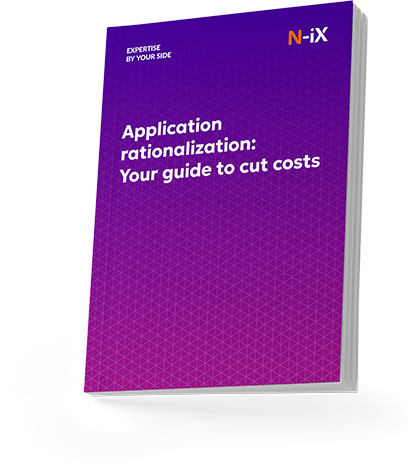

Success!

Complexity of the legacy code
Legacy codebases are often complex, lacking modular structure and proper documentation, which makes even minor changes prone to unexpected failures. This lack of clarity can create significant application modernization challenges when attempting to modernize or scale applications.
How it disrupts operations:
- High risk of system instability
Even small changes in legacy code can cause system instability, leading to unexpected failures and costly downtime.
- Longer development cycles
The complexity of the code often results in longer development cycles for adding new features, delaying innovation and time to market.
- Increased QA and testing time
Extensive testing and QA are required to ensure that changes don’t break the system, which slows down release cycles and increases overhead.
How to mitigate these issues:
- Perform automated static analysis
Use automated tools to map hidden dependencies and identify potential areas of risk, helping developers understand the codebase better.
- Isolate high-value modules
Prioritize isolating and refactoring high-value modules, wrapping them with automated tests to ensure stability and reduce the risk of failures.
- Introduce CI/CD pipelines
Implement continuous integration and continuous delivery (CI/CD) pipelines to catch regressions early, streamline development, and accelerate release cycles.
Learn more about our software code audit services
Knowledge loss
Over time, as key knowledge holders leave, valuable information about the system often leaves with them. Without proper documentation, new team members struggle to fully understand the intricacies of the legacy application, leading to operational inefficiencies.
How it disrupts operations:
- Slow response to regulatory changes or security threats
Without a clear understanding of the system, adapting to new regulations or responding to security threats becomes slower and more challenging.
- Increased onboarding time for developers
New team members spend significant time getting up to speed, which slows down overall development and productivity.
- Risk of incorrect modifications or accidental data loss
A lack of insight into the system increases the likelihood of making mistakes when modifying the code, risking data corruption or loss.
How to mitigate these issues:
- Schedule knowledge-transfer interviews
Conduct interviews with remaining experts to document their knowledge and ensure critical information is passed down to new team members.
- Reverse-engineer and re-document critical components
Analyze the system to reverse-engineer undocumented components and create comprehensive documentation to ease future development.
Lack of internal tools for traceability and monitoring
Without clear visibility into system behavior, teams struggle to effectively track performance, errors, and changes, leading to a lack of insight into the health of their applications. This can significantly hinder operational efficiency.
How it disrupts operations:
- Prolonged incident resolution times
The inability to monitor system behavior in real-time makes it difficult to pinpoint the root causes of issues, resulting in longer incident resolution times.
- Difficulty tracking the impact of changes or bugs
Without visibility, it’s challenging to understand how changes or bugs affect the system, leading to a reactive, rather than proactive, approach to problem-solving.
- Inability to proactively detect and fix system degradation
A lack of monitoring makes it difficult, if not impossible, to detect performance issues early on. This, in turn, leaves issues to escalate before they are addressed.
How to mitigate these issues:
- Deploy an observability stack
Implement tools like OpenTelemetry, Prometheus, and Grafana to gain real-time insights into system performance, errors, and bottlenecks.
- Introduce distributed tracing
Before making significant changes, incorporate distributed tracing to monitor how data flows through the system and identify potential issues early.
- Baseline current performance
Establish a performance baseline to measure current system performance and track improvements over time, ensuring that any gains from modernization are quantifiable.
Now, let’s delve into the next set of challenges: those related to an organization’s readiness for modernization. These challenges can arise when there is a misalignment between business goals and technology teams, insufficient skills or resources, or a lack of a clear, strategic plan for modernization. Understanding and addressing these readiness issues is crucial for laying the foundation of a successful modernization journey.
Readiness for modernization and related legacy application modernization challenges
Modernization efforts fail when organizations lack a clear roadmap, governance, or technical readiness. Jumping in without assessing people, process, and tech maturity will lead to wasted costs.
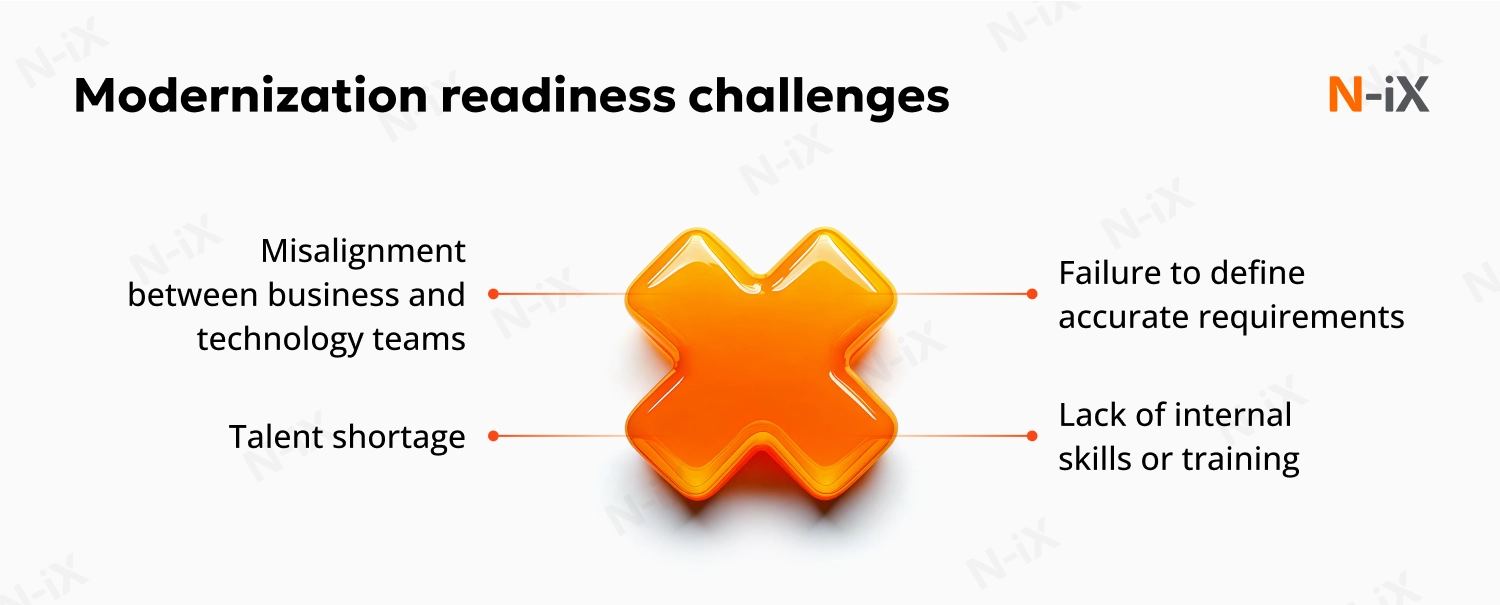
Misalignment between business and technology teams
Different success metrics stall progress and breed frustration. When business teams seek quick wins and IT focuses on architecture, goals diverge and priorities conflict.
When an organization is not fully prepared for modernization, it can lead to significant disruptions in operations. Misalignment between business goals and technology teams, coupled with a lack of clarity around the modernization process, often causes friction and inefficiencies.
How it disrupts operations:
- Loss of stakeholder confidence in IT capabilities
If the modernization process lacks clear direction, stakeholders may lose trust in the IT team's ability to deliver results, affecting overall business confidence.
- Missed deadlines and market opportunities
Poor alignment and lack of preparedness can lead to delays in the modernization effort, resulting in missed deadlines and lost market opportunities.
- Scope creep or feature bloat
Without a shared vision, the scope of the project can expand uncontrollably, adding unnecessary features that divert focus from key business needs.
- Frustration between departments
When teams are not working toward common goals, tensions can rise, leading to poor collaboration and a fragmented approach to modernization.
How to mitigate these issues:
- Run a formal readiness assessment
Conduct a thorough evaluation of your current architecture, skills, and governance to identify potential gaps and prepare your organization for modernization.
- Set shared OKRs
Establish clear objectives and key results (OKRs) for speed, quality, and customer impact that align all teams toward a common goal.
- Form cross-functional teams
Create cross-functional teams with joint accountability to drive collaboration and ensure all perspectives are considered throughout the modernization process.
- Hold regular demos
Implement regular demos to provide rapid feedback, manage scope effectively, and keep the project on track, ensuring all stakeholders stay aligned.
Inability to define accurate requirements
Poorly articulated requirements can lead to solutions that fail to meet the actual needs of the business. When workflows or edge cases are not clearly defined upfront, they tend to surface only after the system is live, causing disruptions that could have been avoided with proper planning.
How it disrupts operations:
- User resistance
If key features are missing or misaligned with user needs, it often leads to resistance, reducing the adoption and effectiveness of the solution.
- Ineffective solutions
Solutions built without clear requirements are often inefficient, leading to wasted investment and a failure to address the business’s real needs.
- Increased support tickets and insufficient productivity
As users encounter issues with the system, the volume of support tickets increases, and overall productivity declines as time is spent resolving problems rather than advancing work.
- Costly hotfixes
When requirements aren’t defined correctly, urgent fixes become necessary, incurring additional costs and disrupting the development schedule.
How to mitigate these issues:
- Run discovery workshops
Collaborate with business analysts and end users early on to gather comprehensive insights and ensure that all needs are clearly understood.
- Capture user stories with acceptance criteria
Ensure that each feature has well-defined user stories, complete with acceptance criteria and measurable outcomes, to provide clear direction for development.
- Prototype high-risk areas
Focus on prototyping high-risk or complex areas to validate assumptions and identify potential issues before they become costly problems down the line.
Lack of internal skills or training
A lack of internal skills or training can pose a significant challenge, especially when teams that are comfortable with monolithic architectures struggle to adapt to modern technologies like Kubernetes, Infrastructure as Code (IaC), and serverless computing. Without the necessary expertise, the transition to these new approaches can be fraught with difficulties.
How it disrupts operations:
- Increased operational risks and system instability
Without the right skills, teams may struggle to implement and manage modern technologies, leading to system instability and higher operational risks.
- Difficulty troubleshooting production issues
Lack of familiarity with new systems can make it harder to diagnose and resolve issues quickly, which can slow down problem resolution and affect system performance.
How to mitigate these issues:
- Launch role-based learning paths
Develop structured learning paths tailored to specific roles, offering training and certification incentives to upskill internal teams and prepare them for the complexities of modern technologies.
- Pair legacy developers with cloud consultants
Facilitate on-the-job coaching by pairing legacy developers with cloud consultants, allowing them to learn through hands-on experience and gain practical insights.
- Budget dedicated “training sprints”
Allocate time and budget for dedicated training sprints within project plans, ensuring that team members have the opportunity to build new skills and stay ahead of technological advancements.
Talent shortage
The market for cloud architects and DevOps engineers is highly competitive, making it difficult for organizations to secure the skilled talent they need for modernization efforts.
How it disrupts operations:
- Missed business opportunities
Stalled development due to a lack of skilled professionals can result in missed business opportunities and delayed critical projects.
- Overloaded internal teams
The pressure on existing staff increases as they take on more responsibilities, leading to burnout and reduced productivity.
- Growing backlog of tech debt
Without the necessary resources, technical debt and critical fixes pile up, further delaying progress and escalating maintenance costs.
How to mitigate these issues:
- Leverage nearshore or offshore staff augmentation partners
Tap into external talent pools by partnering with nearshore or offshore providers, allowing you to access skilled professionals without the high costs of local hiring.
- Promote engineering culture
Foster a strong engineering culture by encouraging open-source contributions and hosting tech talks, helping to attract top-tier talent who align with your values and mission.
Now, let’s shift our focus to the business-related software modernization challenges that can impede modernization efforts, and explore how to overcome them while aligning technology with overarching business goals.
Business-related application modernization challenges
In this section, we will take a look at the challenges that are often rooted in concerns about risk, cost, and disruption. While technology upgrades are essential, they must align with business objectives and address organizational fears around change.
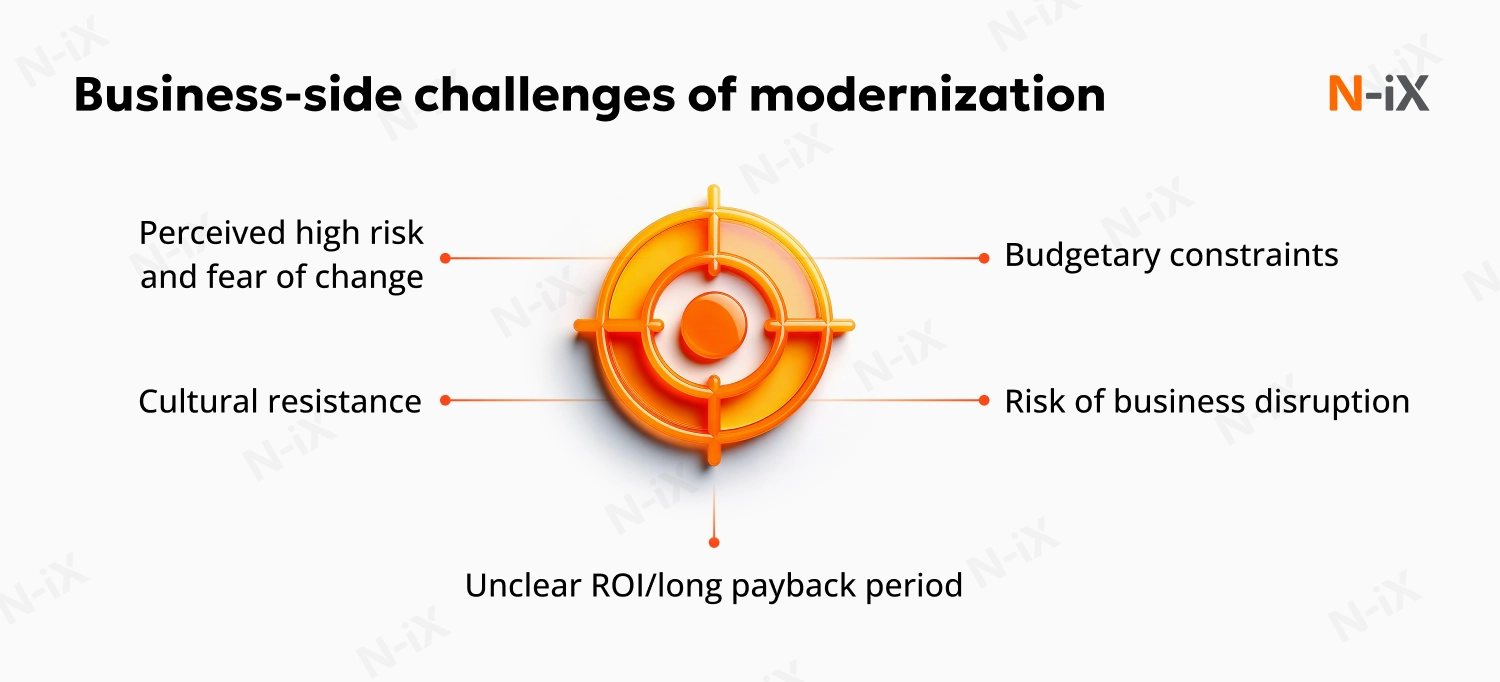
Perceived high risk and fear of change
Many organizations hesitate to modernize mission-critical workloads, fearing disruption to core processes and operations.
How it disrupts operations:
- Legacy systems become bottlenecks
When modernization is avoided, legacy systems can become significant obstacles to innovation, hindering the company’s ability to evolve and meet market demands.
- Competitors gain an edge
Competitors who embrace modern technologies can quickly outpace the business, offering superior customer experiences and increased agility.
- Risk avoidance leads to stagnation
Continuous risk avoidance can result in long-term stagnation, where outdated systems prevent the company from advancing or adapting to new opportunities.
How to mitigate these issues:
- Start with a low-risk pilot
Begin with a small-scale pilot project to test the waters and share success metrics with the key stakeholders to demonstrate the value of modernization.
- Maintain rollback plans and dual-run periods
Ensure that critical processes have robust rollback plans in place, with dual-run periods to minimize the risk of disruption during the transition.
- Showcase peer benchmarks
Use industry benchmarks from similar organizations to reassure stakeholders that the move towards modernization is both feasible and necessary for long-term success.
Budgetary constraints
Modernization often competes for funding with ongoing feature work, and without sufficient resources, these efforts can become fragmented or delayed. As a result, the push for modernizing systems is sidelined, hindering long-term progress.
How it disrupts operations:
- Hybrid environments increase complexity and costs
Managing both legacy and modern systems in parallel can create operational complexity and raise costs, as teams must maintain two environments.
- Teams spend more time on workarounds
Instead of focusing on innovation, teams end up spending significant time developing temporary solutions to address gaps between old and new technologies.
How to mitigate these issues:
- Break the program into value-based increments
Divide the modernization program into smaller, value-driven phases to ensure continuous progress and measurable outcomes.
- Come up with a KPI for each phase
Link each phase of modernization to a specific cost-saving or revenue-generating KPI to demonstrate clear business value and justify funding.
- Use cloud cost-simulation tools
Leverage cloud cost-simulation tools to estimate and track the ROI of modernization efforts, ensuring that the business can monitor and assess the financial impact of the transition.
Risk of business disruption
Unplanned downtime during modernization can have a significant impact on business operations, eroding customer trust and causing lasting damage. Whether it’s due to downtime, data migration failures, or bugs during rollout, these disruptions can be detrimental to the smooth functioning of the business.
How it disrupts operations:
- Loss of revenue and customer trust
Any downtime or system failures can result in lost revenue and a decline in customer trust, which can take a long time to rebuild.
- Increased pressure on support and engineering teams
Support and engineering teams face higher stress levels as they work to resolve issues quickly, diverting attention from ongoing development and innovation.
- Damaged brand reputation
Repeated disruptions can tarnish the company’s reputation, leading to a loss of competitive advantage and customer loyalty.
How to mitigate these issues:
- Adopt blue-green or canary deployments
Use deployment strategies like blue-green or canary deployments, which allow for smoother rollouts and automated rollbacks in case of failure, reducing the risk of disruption.
- Rehearse disaster recovery training
Conduct regular disaster recovery simulations to ensure teams are well-prepared for major system changes, reducing the potential impact of unexpected issues.
- Schedule migrations during off-peak windows
Plan migrations during off-peak hours to minimize the impact on users, and communicate clearly with users to ensure they are aware of any planned downtime.
Unclear ROI or long payback period
Executives often hesitate to approve modernization efforts when the benefits feel abstract or distant. Without clear, tangible benefits, modernization can be viewed merely as a cost, rather than a valuable investment in the organization’s future.
How it disrupts operations:
- Resistance from business units and executives
Without a clear business case, key stakeholders may resist the modernization initiative, hindering progress and causing delays.
- Stalled future funding for IT projects
Lack of visible benefits can lead to challenges in securing future funding for IT projects, limiting the company’s ability to continue investing in technology.
- Missed opportunities to optimize operations
Without clear follow-through, businesses may miss opportunities to streamline operations, improve efficiency, and remain competitive.
How to mitigate these issues:
- Establish baseline metrics
Set clear baseline metrics for key performance indicators (KPIs) such as deployment frequency, mean time to recovery (MTTR), and infrastructure costs to track improvements over time.
- Report progress in business terms
Communicate progress in terms that resonate with the business, such as faster product launches, reduced churn, and the avoidance of compliance-related fines.
- Keep a running benefits register
Maintain a benefits register that is regularly updated throughout the program to ensure that stakeholders can see the tangible, ongoing value of modernization efforts.
Cultural resistance
People often revert to familiar tools when change feels forced, and employees may cling to old workflows and systems, hindering the adoption of new technologies. This resistance can significantly slow down modernization efforts.
How it disrupts operations:
- Fragmented data usage across the company
As employees continue to use outdated tools, data becomes fragmented, making it harder to achieve a unified view of the business and leading to inefficiencies.
- Underutilized tools that deliver no ROI
New tools and systems may go underused if employees do not fully embrace them, preventing organizations from realizing the return on investment.
- Growing divide between legacy and modern systems
The gap between legacy systems and modern solutions widens, creating silos and increasing complexity in operations.
How to mitigate this challenge for internal users:
- Recruit “change champions” in every department;
- Reward early adopters and share their wins;
- Provide bite-sized learning content and office-hour support.
How to mitigate this challenge for external users:
- Involve experienced users in beta testing;
- Provide in-app guidance and resources;
- Roll out features gradually with clear “what’s new” notes.
You may also be interested in: Guide to application rationalization
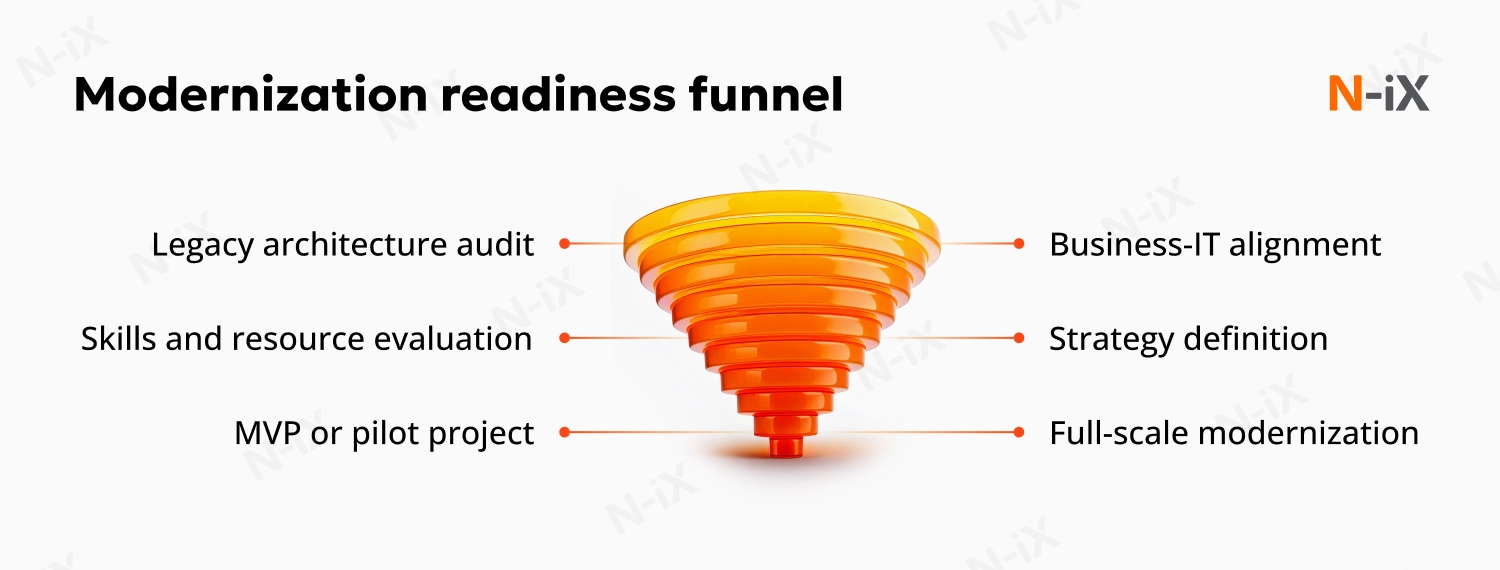
Tech-related application modernization challenges
Lack of a proper modernization strategy
A lack of a proper modernization strategy can result in disjointed efforts, with teams working in silos and technology solutions that are incompatible or redundant. Without a clear roadmap, modernization becomes a patchwork of re-engineering efforts that may end up creating more technical debt than it eliminates.
How it disrupts operations:
- Teams work in silos
Without a unified strategy, teams often operate independently, wasting time and budget on overlapping efforts rather than working toward a cohesive goal.
- Fragmented architecture
The absence of a clear plan results in a fragmented architecture that complicates future software maintenance and increases operational costs.
- Loss of control over project scope and timelines
Without centralized oversight, it becomes difficult to manage the scope and timelines of modernization projects, leading to delays and misaligned priorities.
How to mitigate these issues:
- Conduct an architectural audit
Perform a thorough audit of the current architecture and use the “five Rs” framework (rehost, refactor, rearchitect, rebuild, replace) to prioritize modernization efforts and ensure they align with business needs.
- Sequence initiatives carefully
Organize modernization initiatives in a logical sequence to avoid dependency collisions and ensure smooth implementation across different stages.
- Assign a single program owner
Appoint a dedicated program owner who will have holistic governance over the modernization process, ensuring consistent decision-making and alignment with business goals.
Read more: Application modernization strategy: Executive’s handbook
Choosing the right technologies
Choosing the wrong tech stack can lead to significant challenges down the road. While a modern stack may seem like a good solution initially, selecting a poorly supported or overly complex technology can create future complications, turning it into the next legacy system.
How it disrupts operations:
- Increased future migration costs
If the chosen stack becomes obsolete or unsupported, migrating away from it in the future can be costly and time-consuming.
- Lack of developer community or expertise
A technology with a small or inactive community may lack the support, resources, and expertise necessary for long-term success.
- Technical lock-in with limited flexibility
Some tech stacks can lead to vendor lock-in, making it difficult to switch platforms or integrate new technologies as business needs evolve.
How to mitigate these issues:
- Evaluate tech against community size and vendor health
Assess the technology stack based on the size and activity of its developer community, its long-term roadmap, and the stability of the vendor behind it.
- Run Proof of Concepts
Before fully committing, test the technology through building a proof of concept to ensure it meets your needs and performs as expected.
- Prefer open standards and modular design
Opt for open standards and modular architectures that offer flexibility, making it easier to adapt or change components in the future without being locked into a single solution.
Data migration and integration
Insufficient data can disrupt every aspect of an organization, from reporting to billing. Mismatched schemas, data duplication, and inconsistent formats create significant challenges, particularly when migrating from legacy systems to modern platforms. Poor data quality can introduce serious risks that affect operations and business outcomes.
Potential negative issues include:
- Unreliable or unavailable business-critical data
Inaccurate or inconsistent data can lead to critical business decisions being based on unreliable information.
- Downtime during migration
Data migration issues can cause extended downtime, directly impacting customer experience and service delivery.
- Compliance issues
Mishandling sensitive data during migration can lead to serious compliance violations, including inability to comply with regulations like GDPR or HIPAA law.
- Incompatible data formats
Legacy systems may store data in formats that are not compatible with modern systems, complicating integration and migration efforts.
- Data synchronization issues
Inconsistent synchronization between batch processing systems and real-time systems can lead to discrepancies, further undermining data accuracy.
How to mitigate these issues:
- Clean and deduplicate data before migration
Prior to migration, ensure data is cleaned and deduplicated to avoid carrying over unnecessary or redundant information.
- Use ETL/ELT tools with rollback-capable pipelines
Leverage ETL (Extract, Transform, Load) or ELT (Extract, Load, Transform) tools that support versioning and rollback capabilities to manage data more effectively during migration.
- Validate integrity and reconcile totals post-migration
After migration, validate data integrity and reconcile totals to ensure no data was lost or altered, guaranteeing that the system is functioning as intended.
Keep reading: Data modernization strategy: Rethink enterprise success
Resilience, security, and compliance
Modern technology stacks introduce new attack surface. As systems become more complex, they must not only maintain high availability but also comply with stringent regulatory requirements, increasing the risk of security breaches and operational disruptions.
How it disrupts operations:
- Legal and financial penalties
Failing to meet security standards or regulatory requirements can result in severe legal and financial penalties.
- Loss of client trust
Security incidents or non-compliance can erode client trust, damaging relationships and reputations.
- System downtime due to security incidents
Cyberattacks or vulnerabilities in the system can lead to downtime, affecting business continuity and customer experience.
How to mitigate these issues:
- Embed security scans and policy checks in the CI/CD pipeline
Integrate security scans and compliance checks into the continuous integration and continuous delivery (CI/CD) pipeline to catch issues early in the development process.
- Design for redundancy across availability zones
Ensure systems are designed with redundancy across multiple availability zones to maintain uptime and minimize the risk of service disruptions.
- Document compliance controls and automate evidence collection
Maintain clear documentation of compliance controls and automate the collection of evidence to streamline audits and ensure ongoing regulatory compliance.
Assessing the modernization potential of a new system
Some applications can actually cost more to modernize than to replace entirely, especially when they no longer align with current business needs or technological advancements. This misallocation of resources can hinder overall progress.
How it disrupts operations:
- Misallocation of budget and engineering resources
Investing in the modernization of low-value apps diverts resources away from more critical projects, leading to inefficiencies.
- Opportunity cost of neglecting more critical systems
Focusing on outdated applications may cause the organization to miss opportunities to improve more vital systems, delaying growth or innovation.
- Increased complexity in managing low-value apps
Maintaining and modernizing apps that no longer add significant value increases complexity, making it harder to focus on systems that drive business differentiation.
How to mitigate these issues:
- Score each app on business value, technical risk, and future fit
Evaluate each application based on its contribution to the business, technical feasibility, and how well it fits future goals to prioritize modernization efforts.
- Retire or replace low-value systems
Decommission or replace low-value applications, and reallocate investment toward more strategic, differentiating technologies that deliver greater returns.
- Regularly revisit the portfolio
Continuously reassess the application portfolio as the business strategy evolves, ensuring that resources are invested where they will have the most impact.
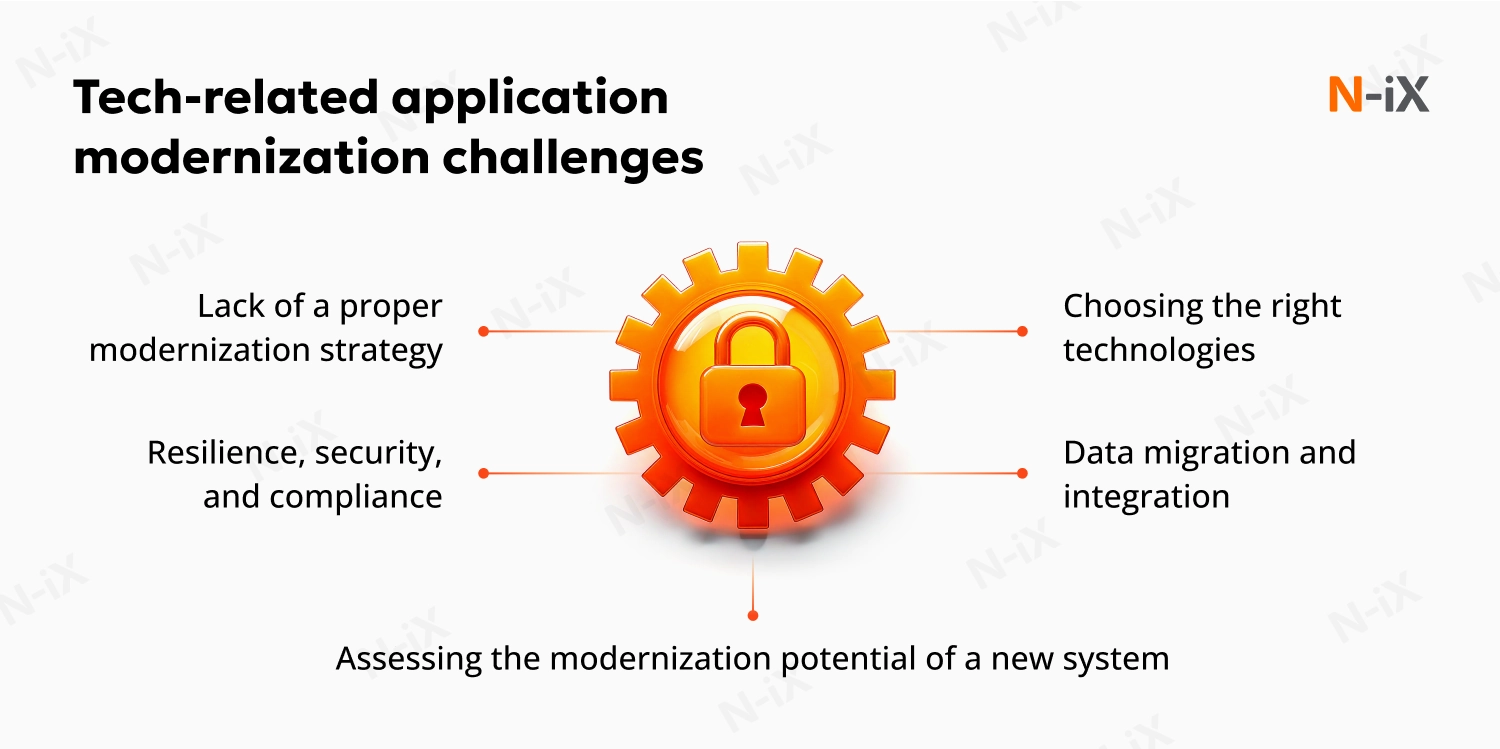
Conclusion: Turning challenges into a competitive advantage
Modernization is rarely a straight line, but every obstacle can be managed with the right mix of strategy, talent, and cultural buy-in. To start, it’s important to align on value first. Each step of the modernization process should be tied to a measurable business outcome, ensuring that efforts are purposeful and aligned with organizational goals.
Investing in people is also crucial. Upskilling internal teams and augmenting with specialized partners when gaps exist will ensure the workforce is equipped to handle the application modernization challenges. Modernizing incrementally is another key approach.
Additionally, embedding observability and security from the outset is critical; they should be viewed as prerequisites, not afterthoughts.
Ultimately, modernization should be seen as an ongoing capability, not a one-off project. By adopting this mindset, your organization will be better equipped to adapt, innovate, and outpace the competition.
Why choose N-iX to help you manage application modernization challenges?
At N-iX, we help businesses modernize their legacy software to achieve automation, scalability, and innovation at scale. With over 23 years of experience and a team of 2,400+ tech consultants and engineers, we provide comprehensive application modernization services, ranging from architecture review and tech stack updates to full-cycle implementation.
Our expertise spans cloud transformation, AI, Machine Learning, DevOps, IoT, and more. Whether addressing technical debt, improving security, or streamlining business operations, we create tailored solutions to elevate your technology and business outcomes.
By leveraging our deep technical expertise and proven methodologies, N-iX ensures that your modernization journey reduces costs, boosts agility, and enhances the overall customer experience, all while keeping your business future-ready.
Partner with N-iX to modernize your systems and stay competitive in an ever-evolving market.
FAQs related to modernizing applications
How can organizations overcome budget constraints in modernization efforts?
Adopt a phased approach, prioritize high-impact systems, and demonstrate value early through pilot projects.
What role does organizational culture play in application modernization?
Culture influences how receptive teams are to change. Without cultural alignment, even the best modernization strategies may fail.
What are the benefits of adopting cloud computing in application modernization?
Cloud enables faster deployments, auto-scaling, improved resilience, and access to advanced technologies like AI and analytics.
How can the success of application modernization be measured?
Success can be tracked via cost reduction, improved system performance, user satisfaction, and faster release cycles.
Have a question?
Speak to an expert




